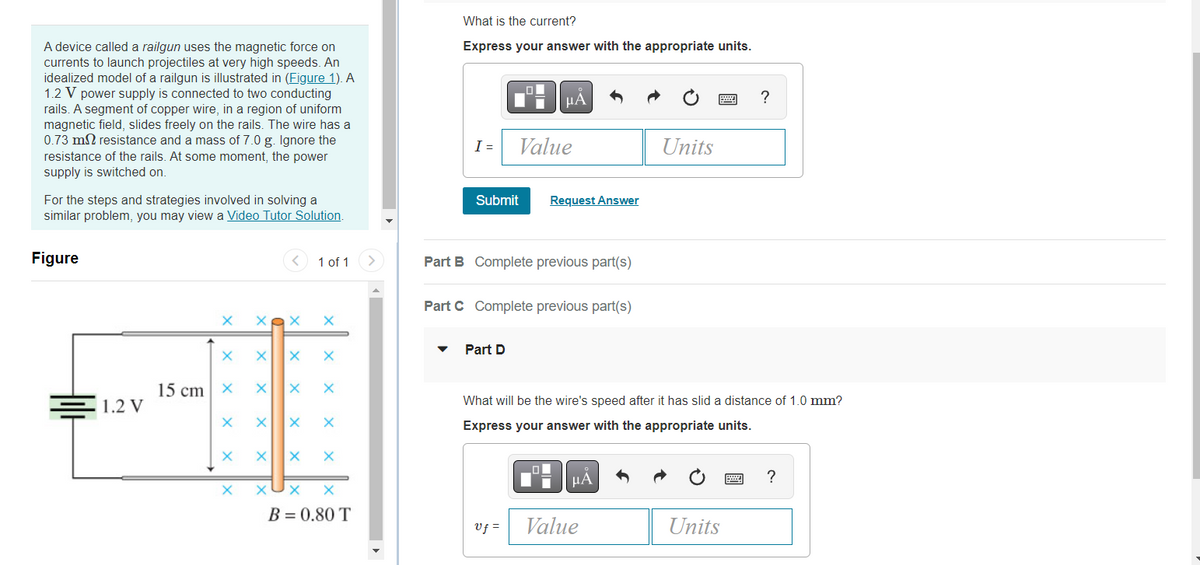A device called a railgun uses the magnetic force on currents to launch projectiles at very high speeds. An idealized model of a railgun is illustrated in (Figure 1). A 1.2 V power supply is connected to two conducting rails. A segment of copper wire, in a region of uniform magnetic field, slides freely on the rails. The wire has a 0.73 m2 resistance and a mass of 7.0 g. Ignore the resistance of the rails. At some moment, the power supply is switched on. For the steps and strategies involved in solving a similar problem, you may view a Video Tutor Solution. Figure 1.2 V X X 15 cm x X xax X 1 of 1 X Xx X X X X X X X X X X X X X X X B=0.80 T > What is the current? Express your answer with the appropriate units. Ti I= Value Submit μA ▾ Part D Part B Complete previous part(s) Part C Complete previous part(s) Request Answer vf= μÀ → Value Units What will be the wire's speed after it has slid a distance of 1.0 mm? Express your answer with the appropriate units. By ? Units Comme ?
A device called a railgun uses the magnetic force on currents to launch projectiles at very high speeds. An idealized model of a railgun is illustrated in (Figure 1). A 1.2 V power supply is connected to two conducting rails. A segment of copper wire, in a region of uniform magnetic field, slides freely on the rails. The wire has a 0.73 m2 resistance and a mass of 7.0 g. Ignore the resistance of the rails. At some moment, the power supply is switched on. For the steps and strategies involved in solving a similar problem, you may view a Video Tutor Solution. Figure 1.2 V X X 15 cm x X xax X 1 of 1 X Xx X X X X X X X X X X X X X X X B=0.80 T > What is the current? Express your answer with the appropriate units. Ti I= Value Submit μA ▾ Part D Part B Complete previous part(s) Part C Complete previous part(s) Request Answer vf= μÀ → Value Units What will be the wire's speed after it has slid a distance of 1.0 mm? Express your answer with the appropriate units. By ? Units Comme ?
Chapter11: Magnetic Forces And Fields
Section: Chapter Questions
Problem 28P: An electron in a TV CRT moves with a speed of 6.0107 m/s, in a direction perpendicular to Earth's...
Related questions
Question

Transcribed Image Text:A device called a railgun uses the magnetic force on
currents to launch projectiles at very high speeds. An
idealized model of a railgun is illustrated in (Figure 1). A
1.2 V power supply is connected to two conducting
rails. A segment of copper wire, in a region of uniform
magnetic field, slides freely on the rails. The wire has a
0.73 m2 resistance and a mass of 7.0 g. Ignore the
resistance of the rails. At some moment, the power
supply is switched on.
For the steps and strategies involved in solving a
similar problem, you may view a Video Tutor Solution.
Figure
1.2 V
X
X
15 cm x
X
X
xax
X
X
X X
< 1 of 1
X X X
X
X
X
XUX
X
X
X X X
X
B=0.80 T
>
What is the current?
Express your answer with the appropriate units.
I =
Submit
Value
Part D
μÅ
Part B Complete previous part(s)
Part C Complete previous part(s)
Uf =
Request Answer
LO
What will be the wire's speed after it has slid a distance of 1.0 mm?
Express your answer with the appropriate units.
O
μA
Units
Value
?
Units
?
Expert Solution
This question has been solved!
Explore an expertly crafted, step-by-step solution for a thorough understanding of key concepts.
Step by step
Solved in 3 steps

Knowledge Booster
Learn more about
Need a deep-dive on the concept behind this application? Look no further. Learn more about this topic, physics and related others by exploring similar questions and additional content below.Recommended textbooks for you


College Physics
Physics
ISBN:
9781938168000
Author:
Paul Peter Urone, Roger Hinrichs
Publisher:
OpenStax College

An Introduction to Physical Science
Physics
ISBN:
9781305079137
Author:
James Shipman, Jerry D. Wilson, Charles A. Higgins, Omar Torres
Publisher:
Cengage Learning


College Physics
Physics
ISBN:
9781938168000
Author:
Paul Peter Urone, Roger Hinrichs
Publisher:
OpenStax College

An Introduction to Physical Science
Physics
ISBN:
9781305079137
Author:
James Shipman, Jerry D. Wilson, Charles A. Higgins, Omar Torres
Publisher:
Cengage Learning